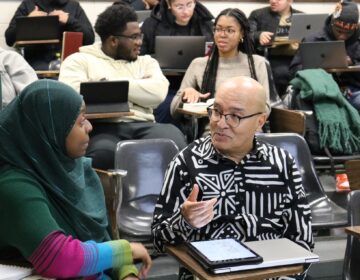Could this N.J. website help integrate America’s schools?
It may not be a panacea, but one Rutgers professor has a new approach for desegregating the nation's schools. And it starts with the college admissions process.
Listen 5:49
Ilona Arnold-Berkovits is an education and family systems researcher and psychometrician at Rutgers University. (Kimberly Paynter/WHYY)
SchoolBonusPoints.org exists in the twilight zone between actual website and digital brainstorm.
Someday it may warehouse data on how economically integrated U.S. schools are — data that could translate into a valuable edge for certain college-bound students.
Right now, it’s more a call to action and the online host of a tantalizing idea: Could colleges drive integration at the K-12 level?
Rutgers researcher Ilona Arnold-Berkovits first had this thought in December and has been mulling it ever since. She launched the website earlier this year in an attempt to attract other thinkers who might support her idea or improve upon it.
At the root, it’s a fairly simple idea.
She thinks colleges should offer an admissions boost — she calls them “bonus points” — to students who attend primary or secondary schools with high numbers of low-income students.
In this alternate universe, kids attending a wealthy school would be at a competitive disadvantage to kids from integrated schools and high-poverty schools.
Colleges would decide how to incorporate these bonus points in their individual admissions processes, but Arnold-Berkovits wants to build the infrastructure. She wants to come up with a bonus-points rubric, and she wants to list bonus points for as many schools as possible. When families thumb through traditional school-ranking lists — which tend to favor high-wealth districts — she wants them to visit her website and know how many “bonus points” they may be gaining (or giving up).
This concept is new and relatively unexplored.
Yale law student Thomas Scott-Railton proposed a similar idea in an article earlier this year, and The Atlantic piggybacked off Scott-Railton’s piece with a recent story of its own. Scott-Railton and Arnold-Berkovits both began thinking about segregation after hearing a “This American Life” episode by New York Times journalist Nikole Hannah-Jones, but the two developed their ideas independently. They just so happened to do all this at the same time.
That’s not the only bit of fortuitous timing.
New Jersey, where Arnold-Berkovits works and where she attended school, was sued last month by a group of advocates claiming its school system was so intensely segregated that it violated the state constitution.
Arnold-Berkovits alluded to that development in an interview last week with WHYY, which you can read excerpts from below.
Districts — especially New Jersey — are becoming even less and less integrated, she said. “Money runs away from less money, or from poverty. And so, to integrate, you’re going to have to change that.”
The interview has been edited and condensed for length and clarity. You can also listen to the interview by clicking the play button above.
—
Traditionally, the way people have tried to change it is to either force or move students in such a way that the K-12 schools are integrated in a mandated way. Busing is the most common example, right? But that is not what this idea is about.
Right. So you can often see that, when something is mandated, the issue is the people with the money have the power to get around the mandate, to make it no longer occur. We’re going to vote you out. I’m going to buy a house somewhere else.
Or go to a private school.
Or go to a private school. So you end up with all these ways that those who have the money and the power to have a choice run their money away from integration. So what is needed is a market force that then makes it desirable to integrate.
And so you’re sitting there thinking … all these market forces are working against integration. And when you mandate integration, it creates crazy backlash. What can we do? And that thought leads you … where?
So that leads you to, what do wealthy people want? And that answer is, often, what their goal of education is, is to have their kid end up at a “good college.” So if you can use that as a market force to incentivize integration, then you can dampen some of these market forces that are very strongly promoting segregation.
So what’s the idea?
So the idea is that, to incentivize voluntary integration, K-12 schools serving economically disadvantaged students [have] a tangible benefit of their own that they could offer. And that would be bonus points toward admissions to selective colleges.
We’ve seen that a lot of middle-income people go to great lengths to give their kids even a small leg up, whether that means a resume boost or a tutor. They’re willing to do a lot to get a little. So maybe you don’t have to offer them that much to get them to change their behaviors in this area. That was one of my thoughts. I don’t know if you thought of this, as well.
I guess. Although, I’m not sure. Human nature is complicated, and so I don’t know how much it will take to change people’s behavior. And actually, that’s the first study that I’m proposing and that is out in a grant proposal right now. I’m working with a marketing researcher at Rutgers University. Marketing is so not my thing. I’m an education researcher, but this is really an economic, marketing type of problem. So I am bringing in an economist, a marketing specialist, and a demographer. These are all important components of understanding how to move forward with this.
The notion is that the college would offer an admissions boost to someone attending a school with a certain threshold of students receiving free and reduced lunch? Is that the framework we’re working with, or is it more flexible than that?
My perspective is you’re really actually trying to incentivize people moving into as low-income a school as possible, from the wealthy side. You want to pull the wealth as deeply into the lower-income side to make integration actually happen. The way it should work is actually an increasing scale of points. As income of a student body decreases, bonus points increase.
[All] that, plus including the student’s individual socioeconomic situation.
So then, what you’d expect to happen is that the poorer students from poorer schools would receive the largest bonus point boost. Wealthier students attending poorer schools and the poorer students attending wealthier schools would receive the next most bonus. The wealthiest students at the wealthiest schools would not receive any bonus.
The idea is that colleges would voluntarily incorporate this into their admissions policies?
This is the next step, because in order to move forward with some of these studies, the universities are going to have to say, “We’ll do this.” But it does fit in with many of their missions, and it does fit in with their goal of diversifying of higher education.
That’s what I was going to ask. What is in it for them? What’s the incentive for the college admissions officer to adopt this policy?
One of the critiques of many of these selective universities is that they’re not very diverse.
So it helps the colleges in their goal of diversifying campuses, potentially?
Exactly.
With any disruption in the market and in the incentives, there are winners and losers. Who potentially stands to lose here?
I think it’s not completely clear. It seems like it could be done in a way that’s not a dramatic shift, but would be kind of a slow shift to increase more low-income, more Hispanic and black students, in selective colleges. What that probably means, in converse, is it’s going to reduce, somewhat, the white and Asian proportion of higher-income students in these institutions.
It would seem that, over time, the losers would be school districts and schools that are highly segregated and have high concentrations of wealth. People buy into those communities at a high price. You’d be devaluing, somewhat, their purchase.
So I think that’s true to the extent that they’ve probably purchased almost at the peak of the market. It would probably revalue them to before the hype started for their district. While it could be seen as a loss, I think of it more as a correction.
And, to your original point, because it would be slow enough — it might be college by college by college, and it might be over a period of 10 or 15 or 20 years — it might just slip under the radar a little bit. Is that part of the appeal in a way?
I don’t know if it’s going to slip under the radar as much as I think there’s nothing to rail against. I think that’s what makes it interesting. It’s not political. You can’t say we’re going to vote you out because there’s no one to vote out.
My thinking has always realized that economic systems have been tremendously, unfairly penalizing black and Hispanic families. And so this was just one way that economics can kind of be tricked.
WHYY is your source for fact-based, in-depth journalism and information. As a nonprofit organization, we rely on financial support from readers like you. Please give today.





